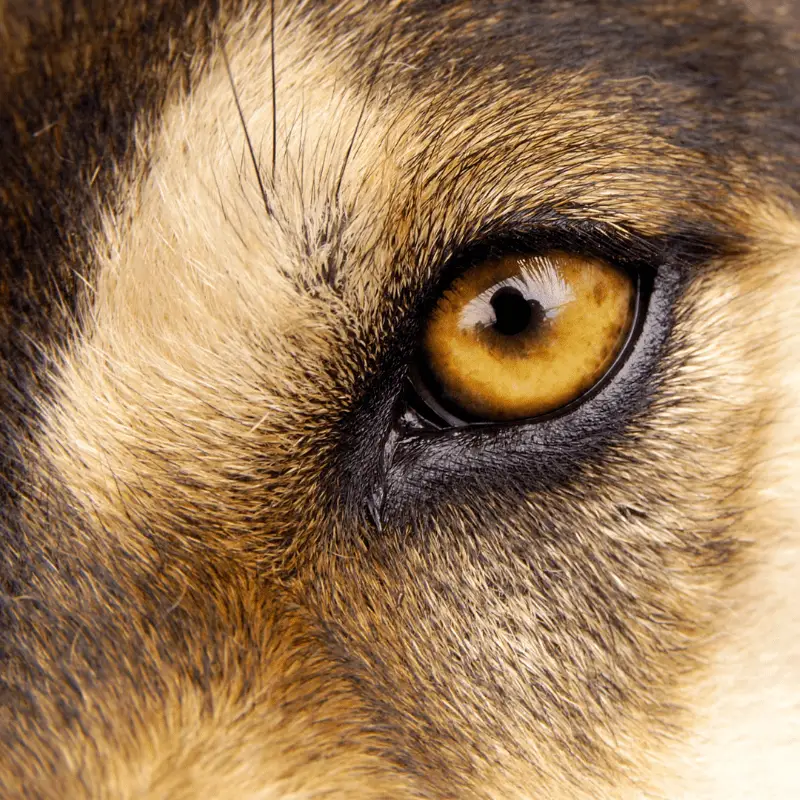Have you ever wondered how your dog sees the world? Have you ever thought if your dog can see the beautiful colours of the rainbow or the lush green tinge of the freshly mowed lawn? Can your four-legged pal identify and distinguish all the different colours like you? Do dogs only have a black and white vision? Let’s learn about the colours that dogs see!
Yes, dogs can see colours. Even though the spectrum of colour the dogs see is not as extensive as their human companions, their world is not entirely black and white. Contrary to popular belief, dogs may have a pretty colourful world similar to us humans.
How The Eyes Work
The eyes of the dogs work much like a camera. Just like human eyes, the iris contracts and expands to control the amount of light it gets inside their eyes. The light enters the eyes of the pupil. Once the light is inside their eyes, it passes through the lens and corona and collides with the light-sensitive layer’s retina.
The retina of dogs’ eyes contains two types of cells. One is rods that detect motion and light levels, and the other is cones that help to see different colours. The retina’s colour, motion-sensitive cone, and rod cells get stimulated, converting the light into electrical signals. These signals are then sent to the brain through the optic nerves. The brain then creates an image for the dog in its brain.
The only difference is that the dogs’ eyes contain two types of cone cells, whereas the human eyes have three types. That is why humans can differentiate various combinations of red, green, and blue. As the dogs have only two types of cones, they can only identify yellow and blue. This limited colour perception makes their vision a dichromatic one.
Dogs have more rod cells compared to humans. That gives them an edge in identifying moving objects or seeing them in low light. That means the dogs can see as much colour as humans suffering from colour blindness.
Can dogs see in the dark?
With the help of the extra light-sensitive cells, called rods, located in a dog’s retina, dogs can see very well in dim light. However, dogs can not see in complete darkness.
What does colour blindness mean?
Colour blindness is a problem that makes it difficult for a person to differentiate between various colours. This problem develops from an abnormality in the colour sensory receptors of the eyes. People suffering from colour blindness can find it difficult to see specific colours.
The problem that a person may face depends on the type of colour blindness they have. People generally suffer from two kinds of colour blindness. One is blue-yellow colour blindness, and the other one is red-green colour blindness. For example, a person with red-green colour blindness cannot differentiate between these two colours.
Are dogs colour blind?
Dogs can see as much colour as people suffering from colour blindness. So does that mean dogs are colour blind? No, dogs are not colour blind. They have dichromatic vision. Even though the dogs cannot see all the colours, they can distinguish various shades of yellow and blue exceptionally well. The only problem is that dogs cannot see green and red very well.
What colours can a dog see?
As dogs have a dichromatic vision, they have a minimal perception of colours compared to humans. Researchers have shown that dogs see the world using a unique colour spectrum. In the colour vision of a dog, blue and yellow mostly dominate. To dogs, colours like blue-green, blue and violet tend to look like various shades of blue. The colours red and green probably look like multiple shades of dark brown and grayscale to a dog.
Other Visual Differences Between Dogs and People
As we have mentioned, canines have some visual advantages over us. The dogs’ eyes are set on the sides of their head, giving them a broader range of peripheral vision compared to humans. However, the visual activity of the dogs is not that great. Humans have more precise depth perception than dogs do.
The pupils of a dog can dialect to a large size, allowing a dog’s eyes to capture a lot of light. The dogs also have reflective cells under their retina, which creates the tapetum. It offers the shiny eyes look in dogs and boost their ability to see in dim lights.
Unlike humans, dogs can see better in low light sensors and detect motion accurately. They can spot even the slightest movements at great distances. As the number of rod cells in their eyes is more than that of humans, dogs can see moving elements far better than we do.
Recommended Read: Why Do Most Dogs Have Brown Eyes?
Why are dogs’ eyes so special?
Nature has created each animal with all the necessary physical traits to help them survive in the world. The visual accommodation of the dogs has enabled them to thrive in the wild. Seeing things in low light and even the slightest movements have significantly helped dogs improve their hunting ability. Their visual ability also helps them understand when they are being hunted and whether they need to escape the situation.
Recommended Read: Why Do Huskies Have Blue Eyes?
Choosing Toy Colours
The funny thing is that most of the dog toys you can find in the market are either in safety orange or red. The problem is dogs cannot identify the colour red. To them, it may appear as something that is dark brown or black. That is what makes it difficult for the dogs to spot their toys. That may explain why your dog tends to ignore the bright red toys you bought. In this situation, your dog is not stubborn about it. Instead, they are just not able to spot it correctly.
- The best-coloured toys for a dog would be yellow or blue.
Now that you know your dog can not see a couple of colours, you should choose the toys accordingly. Consider which of the toys your dog can see easily. This simple theory can explain why your dog goes crazy over the yellow-coloured balls but does not get as excited about the red or pink-coloured balls. So, if you are interested in playing fetch or similar games with your dog, do not choose something red.
- Avoid toys that are red or pink.
Can my dog see the TV?
The TV sounds are probably the most stimulating factor for a dog. However, images often play a significant role as well. The researchers have pointed out that the dogs’ flicker rates are higher than their human companions. That means humans can see 60 frames per second while dogs can see about 70 frames per second. That means that if the television has a higher resolution screen, it can offer better entertainment to your dog.
Sighthound Vision
Do you know that dog breeds were specially bred to enhance their sight and give them a better hunting ability? These dogs have a whopping 240 degrees wide field of vision, which allows them to scan the horizon, searching for possible prey. Their retina has a visual streak, a horizontal area with many cone cells. That is what offers these dogs panoramic viewing abilities. Interestingly, this feature is noted only among dogs with long noses. Short-snouted dogs, like chihuahuas or Boston terriers, have a shorter streak than them.
Sighthound Dog Breeds
- Afghan Hound
- Azawakh
- Borzoi
- English Greyhound
- Ibizan Hound
- Irish Wolfhound
- Italian Greyhound
- Saluki
- Sloughi
- Spanish Greyhound
- Whippet
Basenji
Basenji, however, has some discrepancies, that this type of dog should be classed as a sighthound and a scenthound, and some even say neither. Basenji dogs have the traits of both a sight and a scent hound.
Are sighthounds good dogs?
Yes, sighthounds are easygoing with a gentle and mellow demeanour. They love to have bursts of playful times. However, sighthounds can run off on a chasing spree if not appropriately trained or kept on a leash.













